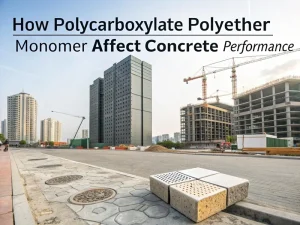Blog
Polycarboxylate ether (PCE) powder, one of the most advanced water-reducing agents in modern concrete technology, can significantly enhance the workability, strength, and durability of concrete when used properly. Compared to liquid PCE, its powder form offers advantages such as convenient storage, longer shelf life, and flexible dosage adjustment, making it particularly suitable for pre-mixed concrete mixing plants, on-site mixing projects, and precast concrete production scenarios. However, improper use (such as incorrect dosage, disorderly mixing sequence, or incompatibility with other materials) may lead to problems, including concrete segregation, delayed setting, or decreased strength.
This article will help you understand the key steps, dosage principles, mixing process, and troubleshooting techniques for use PCE powder, and assist you in correctly using PCE powder to fully leverage its advantages in concrete applications.
PCE powder is a high-performance and efficient water-reducing agent made of polycarboxylate ether polymer. Its core function is to reduce the amount of water used in mixing (with a water reduction rate of up to 20% -40%) while ensuring the workability of concrete remains unchanged (or improved). This “water reduction effect” can directly bring three major advantages:
Improving compressive strength: Reducing water usage makes the internal structure of concrete denser, and the strength can be increased by 15% -30% (crucial for load-bearing structures such as high-rise buildings, bridges, and industrial floors).
Optimise workability: enable concrete to have good fluidity and easily fill dense steel gaps or complex templates (achieving the flow effect of self-compacting concrete SCC with high dosage).
Enhance durability: Low water-to-cement ratio reduces the permeability of concrete, making it more resistant to freeze-thaw cycles, steel corrosion, and chemical erosion.
The correct use of PCE powder is a prerequisite for leveraging these advantages. Even small errors (such as 1% over mixing) can lead to concrete segregation (aggregate sinking, moisture rising) or slow setting, resulting in project delays and material waste.
The primary task before using PCE powder is to verify its compatibility with the key raw materials of concrete; incompatibility is the main cause of performance failure. Focus on the following three types of materials:
1. Cement type
PCE powder has the best compatibility with Portland cement (OPC), but different cement compositions can affect its effectiveness:
Portland cement (Type I/II): fully compatible and can be used directly within the standard dosage range;
Mixed cements (such as PPC mixed with fly ash and PSC mixed with slag) require initial compatibility testing to be conducted. Fly ash or slag may adsorb some PCE molecules, and the dosage needs to be appropriately increased (by 5% -10%) to achieve the expected workability.
Fast-hardening cement: Avoid high dosage PCE; otherwise, it will prolong the setting time. PCE models with low dosage and high efficiency should be selected to specifically meet the requirements of fast-hardening concrete.
2. Aggregates
Fine aggregate (sand): The clay content should be less than 3%. Clay particles will adsorb PCE, reducing its water-reducing effect and requiring additional dosage. If the clay content in the sand is too high, it should be cleaned before use.
Coarse aggregate (crushed stone/pebble): It needs to be clean, free of impurities (no soil, organic matter), and well graded. Due to high friction, angular aggregates require an appropriate increase in PCE content compared to spherical aggregates.
3. Other additives
Do not mix PCE powder with incompatible additives before testing:
Compatibility types: air entraining agent (to enhance frost resistance), retarder (for high temperature environments), early strength agent (for low temperature environments) – but the effect of the dosage combination needs to be verified through small-scale experiments first.
Incompatible type: Lignosulfonate water reducer (traditional low-efficiency water reducer). Mixing the two can cause premature thickening or segregation of concrete.
Professional suggestion: Conduct small-scale experiments to verify compatibility first. Mix PCE powder with the actual raw materials used, test the workability (slump) and setting time of concrete, and apply it on a large scale after the results meet the project requirements.
The dosage of PCE powder is not a one-size-fits-all solution and needs to be adjusted according to the concrete mix proportion, project requirements (such as workability and strength grade), and environmental conditions. Calculate the reasonable dosage according to the following principles:
1. Based on the recommended dosage range by the manufacturer
Legitimate PCE powder suppliers will provide a dosage range (usually 0.1% -0.5% of cement quality), which needs to be combined with product efficiency:
Ordinary PCE powder (water reduction rate of 20% – 30%): The commonly used dosage for ready-mixed concrete is 0.2% – 0.3% of the cement mass.
Efficient PCE powder (water reduction rate of 30% -40%): The commonly used dosage for self-compacting concrete (SCC) or high-strength concrete (M50 and above) is 0.3% -0.5% of the cement mass.
2. It is strictly prohibited to exceed the maximum recommended dosage – excessive dosage can lead to:
Concrete segregation and bleeding (surface water accumulation);
Condensation delay (2-3 times longer hardening time);
Early strength decline (greatly affecting precast concrete that requires rapid demolding).
3. Adjust the dosage based on environmental conditions
Environmental factors can affect the PCE effect, and the dosage needs to be adjusted accordingly
High temperature environment (>25 ℃/77 ℉): Increase the dosage by 5% -10% (such as from 0.2% to 0.22%). High temperature accelerates water evaporation, and additional PCE can maintain workability.
Low temperature environment (<10 ℃/50 ℉): the dosage is reduced by 5% -10% (such as from 0.3% to 0.27%). Low temperature slows down cement hydration, and excessive PCE will further prolong the setting time.
Wet environment: No significant adjustment is needed, as humidity can slow down water loss, and the standard dosage can meet the requirements.
This is a crucial step in transforming PCE powder from a “solid” to a “usable liquid”.
Prepare solvent: Use a portion of the mixed water planned for the batch concrete as the solvent.
Recommended dissolution ratio: To ensure sufficient dissolution, it is recommended to prepare PCE powder as an aqueous solution with a concentration of 10% to 30%. A common practice is to dissolve the PCE powder in a 1:4 weight ratio (1 part PCE powder to 4 parts water).
Based on the above example, 0.8 kg of tetrachloroethylene powder requires a water solubility of 3.2 kg (0.8 kg x 4).
Operation method:
1. Pour the measured water into a clean container.
2. Start a low-speed mixer (such as a handheld electric drill with a mixing blade).
3. Slowly add the metered amount of tetrachloroethylene powder to the stirring water. The solution instantly interferes completely.
4. Continue stirring for 5-10 minutes until the solution is clear and translucent, without any visible particles or clumps.
The timing of adding the used PCE solution to the concrete mixer is also crucial.
The best feeding sequence recommended by the industry (“the latter method”) is:
1. Add most of the aggregates (stones, sand) and about 70% -80% of the mixed water into the mixer and stir for 30-60 seconds to fully wet the surface of the aggregates.
2. Add all cementitious materials (cement, fly ash, etc.) and continue stirring.
3. Finally, add the pre-dissolved tetrachloroethylene solution to the mixer along with the remaining 20% -30% mixed water.
4. Stir thoroughly for at least 90-120 seconds to ensure that all components are evenly mixed.
This method can prevent PCE powder from being prematurely “wrapped” by dried cement particles and becoming ineffective, thus maximising its dispersion effect.
After mixing, observe the condition of the concrete. Its liquidity (slump expansion) should significantly increase. If the effect is not ideal, check if there are any errors in the above steps, rather than simply adding more PCE powder.
If PCE powder is stored improperly, it is prone to failure due to exposure to moisture, high temperatures, or contamination. The following storage rules should be followed:
Keep dry: Store in sealed, moisture-proof packaging bags or containers. A small amount of moisture can cause powder to clump, preventing it from dissolving evenly and potentially damaging the performance of concrete.
Temperature control: Store in a cool, well-ventilated place (15-25 ℃/59-77 ℉), avoiding direct sunlight or proximity to heat sources (such as cement silos). High temperatures can cause the PCE polymer to decompose, reducing its water-reduction efficiency.
First in, first out (FIFO): Prioritise the use of earlier batches of powder. The shelf life of unopened and properly stored PCE powder is 6 to 12 months. After opening, it should be used up within one month, and the bag should be sealed immediately after each use.
Avoid pollution: Do not mix with cement, aggregates, or other additives. Cross-contamination (such as cement dust mixed with PCE) can change the actual dosage and affect the effectiveness of use.
Error 1: Dry powder feeding.
Consequences: clumping, invalidity, uneven performance.
Error 2: Improper dosage.
Consequence: The annual amount is too small, resulting in no water reduction effect. Excessive amounts per year may lead to serious consequences, including loss of coagulation, bleeding, and excessive retardation.
Error 3: Insufficient dissolution.
Consequence: Clumps form in the solution, and the actual PCE concentration during operation is lower than expected, resulting in reduced effectiveness.
Error 4: Compatibility issues with other additives.
Consequence: If it is necessary to use it in combination with other additives such as air-entraining agents and retarders, compatibility tests must be conducted in advance. Especially, PCE is usually incompatible with ethylene-based water reducers.
In summary, the core principles of using PCE powder correctly can be summarised into three points: accurate calculation, complete dissolution, and correct feeding. By following the correct steps above, common problems can be effectively avoided, ensuring that concrete meets or even exceeds project requirements.
By mastering the standardised process detailed in this guide, you can not only avoid costly errors but also fully utilise the excellent performance of PCE powder to create high-performance concrete with stable quality for your project.

How Polycarboxylate Polyether Monomer Affect Concrete Performance
Blog How Polycarboxylate

How Polycarboxylate Superplasticizer Interacts With Slag In Concrete
Blog How Polycarboxylate